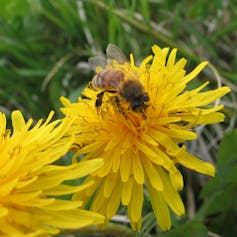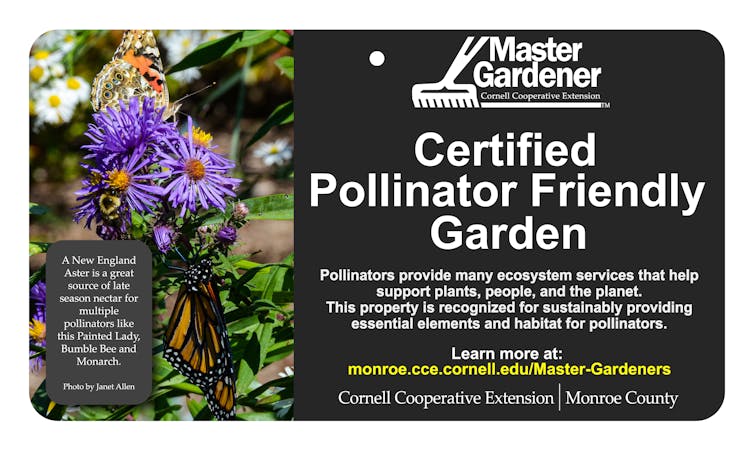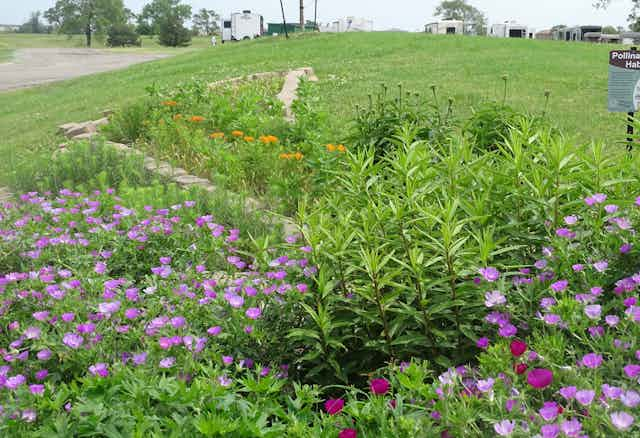It’s a simple idea: Stop mowing your lawn in the month of May to let flowers in the lawn, such as dandelions and clover, grow and support bees and other pollinators.
“No Mow May” was started in 2019 by Plantlife, a conservation charity based in the United Kingdom, in response to a well-documented loss of meadows and an alarming decline of native plants and animals there. Since then, it has been taken up by many gardeners and conservation advocates in North America.
Studies have shown that many flowers that grow in unmown British lawns do support British pollinators. But North America has vastly different ecological communities, composed of unique flora and fauna.
If you are interested in supporting pollinators, it is important to consider the ecological context of your yard – and #NoMowMay may not be an effective strategy. As entomology researchers who run programs on pollinators, we see better ways for people in North America to help pollinators flourish in their yards.
What grows in North American lawns?
Most common lawn flowers in North America are not native to this continent but were brought here from Europe and Asia. Many, such as bull thistle, are noxious weeds that can displace native plants and contribute to problems such as soil erosion. Others, such as ground ivy, are aggressive, invasive weeds in natural areas.
Allowing these weeds to grow can increase their numbers in the landscape and potentially reduce native biodiversity by creating near-monocultures. Not mowing your lawn and allowing these plants to spread can create weed pest problems that people on neighboring properties likely will have to manage with herbicides.
You will find pollinators on lawn flowers, but looks can be deceiving.
Some nonnative lawn plants are very attractive to pollinators. Thistle, crown vetch and, to a lesser degree, dandelion and white clover are commonly visited by bees. This attractiveness helps invasive plants get pollinated, set seed and spread effectively.
But the pollinators you see on these nonnative plants are already the most common in the landscape. Adding these plants to a landscape does not improve North American pollinator communities or support biodiversity.

The dominance of a few pollinator species on these plants may indicate that human influence has reduced the number of species in that ecosystem. Typical human-altered landscapes have a small number of cosmopolitan weedy plants – species found in a broad range of habitats in many parts of the world – and a handful of pollinator species.
For example, a 2014 study that examined urban and suburban lawns in Kentucky found that 90% of spring insects visiting dandelions there belonged to one bee species, the nonnative honeybee; one butterfly species, the common branded skipper; and a few hoverfly species. Honeybees represented nearly 50% of pollinators visiting white clover in spring, followed by hoverflies and a few bumblebee species.
Surrounding landscapes matter too
Few home gardens are large enough to support pollinator populations. A dandelion meadow in a city neighborhood dominated by steel and concrete would look like a pollinator haven, simply because there would be nothing else nearby for bees to feed on. But very few bees would visit the dandelions, and they would be species of bee that were common across the whole landscape, just as most birds in the area would be pigeons or house sparrows.
In a nature reserve, that same dandelion meadow would attract a more diverse community of pollinators. But it still would be dominated by the common generalist species that visit many types of flowers and are not very picky. When more specialized pollinators appear in backyards, they are spilling over from adjoining landscapes that don’t include lawn plants.
A 2016 study found this pattern on suburban lawns in Springfield, Massachusetts. Researchers collected 5,331 bees belonging to 111 species flying around small suburban lots over a two-year period. Just 13 species accounted for 4,442 individual bees they collected, while 81 species were each represented by 10 or fewer individual bees.
Plant diverse native plants
Instead of taking a pause on mowing and letting nonnative plants dominate the spring landscape, we recommend planting a diverse range of native trees, shrubs and herbaceous flowering plants.
Native North American plants and pollinators have evolved together over time. The plants have traits that allow for specific interactions, the right bloom times and the right kind of nectar and pollen for specific native insects.
Researchers at Penn State’s Center for Pollinator Research, where we both work, have examined the pollen that wild bees and managed honeybees collect to see which plants provided the most nutritional resources for bees. They found that in April and May, flowering trees – including maple, oak and willow – provided the most pollen for bees.
Other North American native plants that pollinators visit, such as Virginia bluebells, columbine and phlox, have evolved to grow in partial shade as trees leaf out above them.

More reasons to mow
Leaving grass unmowed in May or June is also problematic because it creates a favorable habitat for ticks and for wild animals such as deer and rodents that carry ticks. This can increase local risk of tick infestations and tick-borne diseases.
Maintaining shorter grass provides a drier environment that is unfavorable for ticks. It also limits wildlife habitat and food sources, which reduces tick populations.
Finally, letting weeds grow in unmowed lawns can create conflict with neighbors. Whether the concern is aesthetics, local property values or public health, many cities have ordinances that set limits on lawn height and will fine residents who don’t comply.
While we agree that mowed lawns don’t provide much food or support for native species, skipping mowing for a short period doesn’t do much either. Pollinators need flowering plants for the entire growing season, from early spring to winter.
We recommend converting your yard into a true pollinator haven, adding native plants and flower beds over time and potentially turning your entire lawn into a garden. For lists of North American pollinator plants that are native to your region, visit the Xerces Society and Pollinator Partnership. State Master Gardener groups also have detailed information on developing pollinator gardens for your region, such as the Pollinator Garden Certification Program from the Penn State Master Gardeners.

